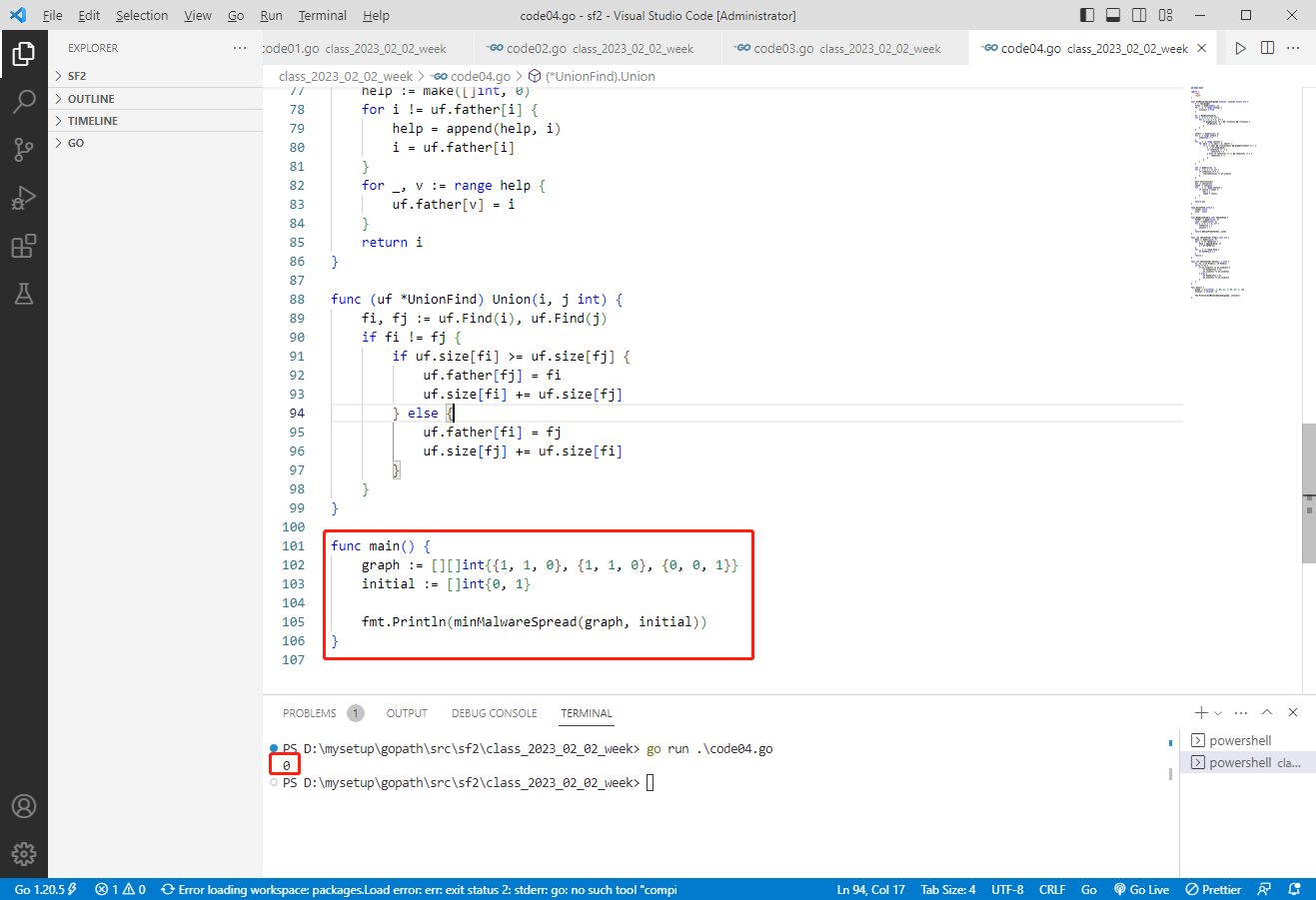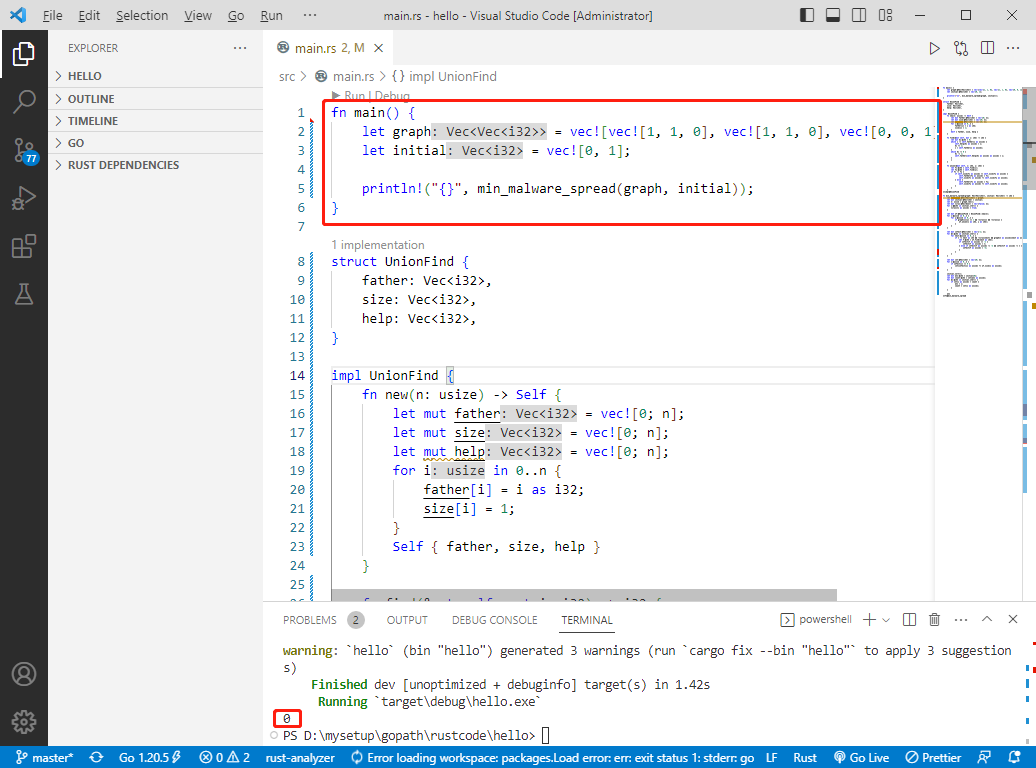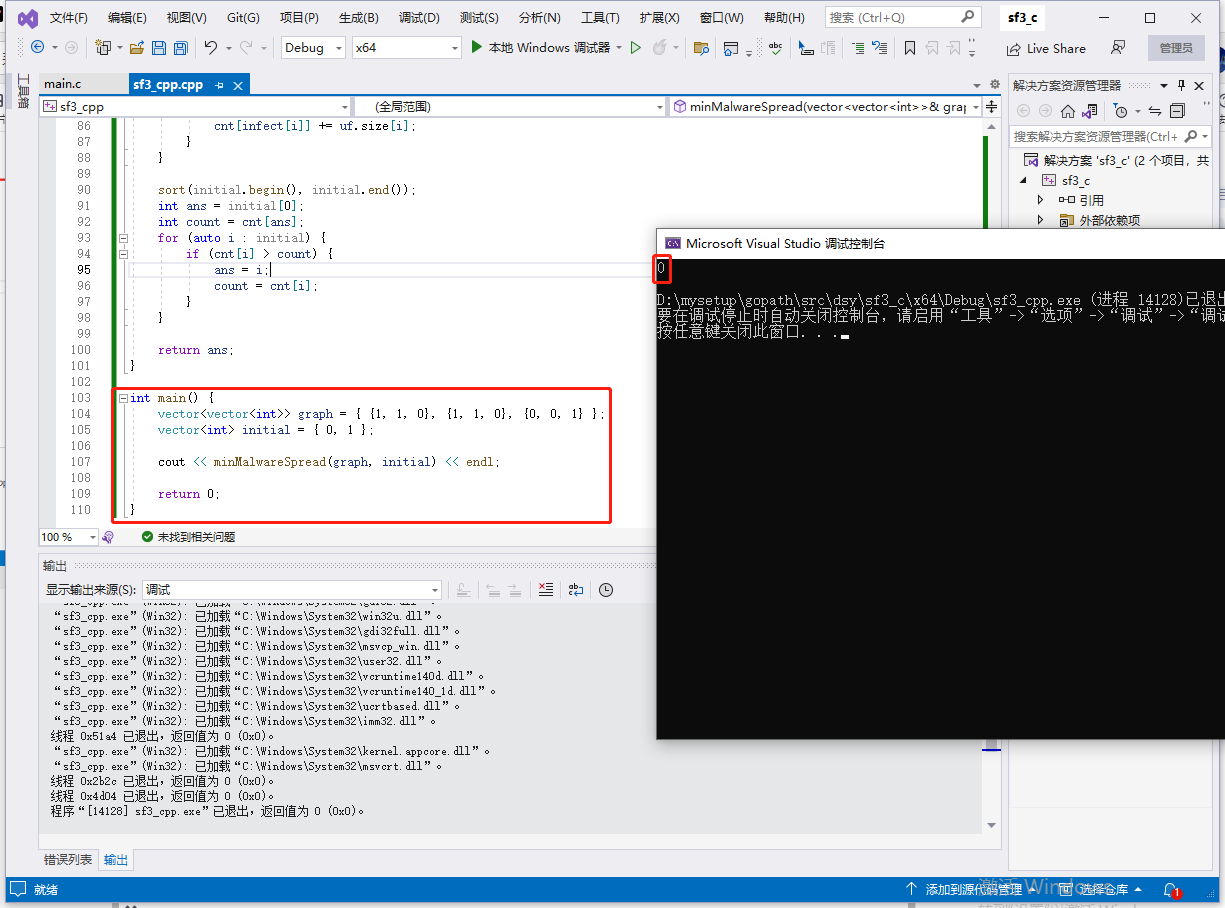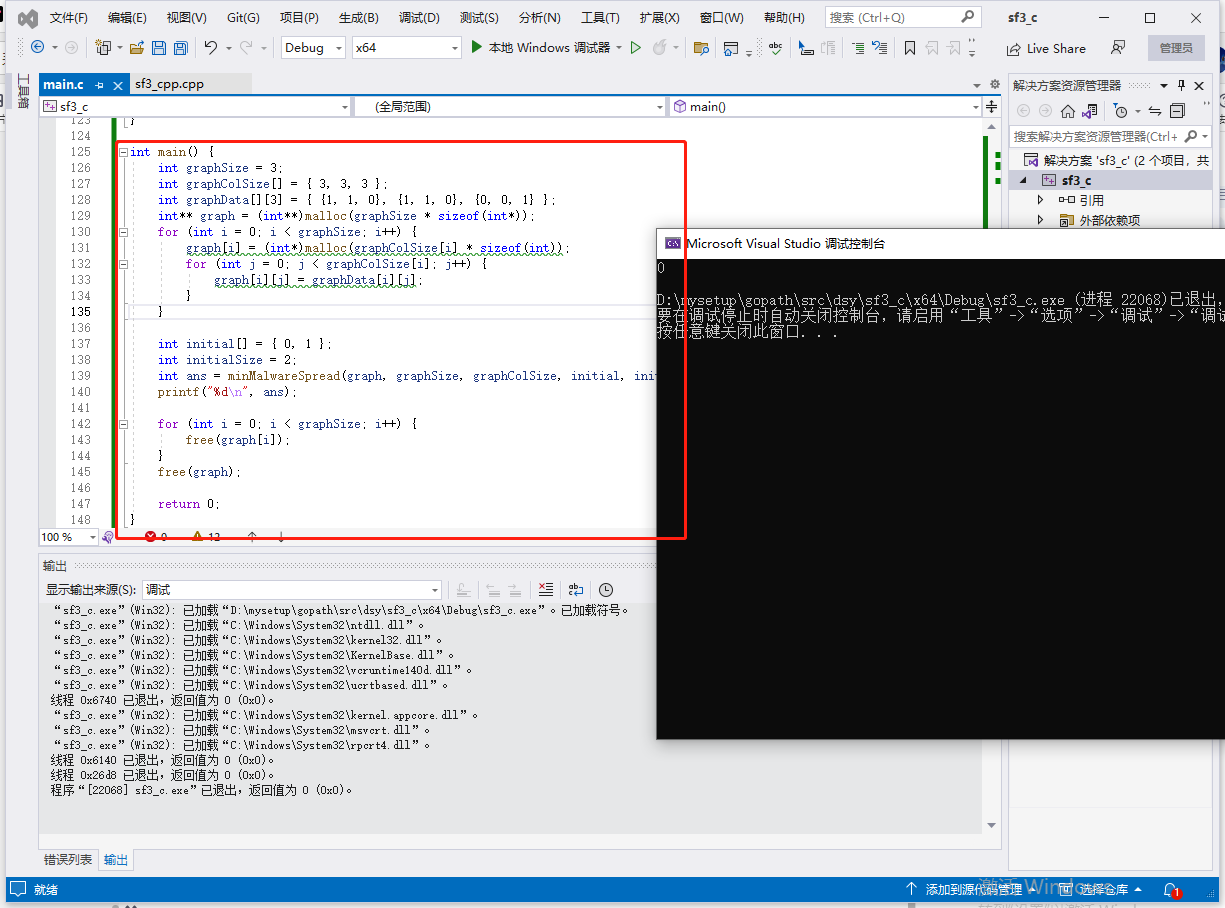2023-06-10:给定一个由 n 个节点组成的网络,用 n x n 个邻接矩阵 graph 表示 在节点网络中,只有当 graph[i][j] = 1 时,节点 i 能够直接连接到另一个节点 j。
- 2023-06-10 北京
本文字数:6165 字
阅读完需:约 20 分钟
2023-06-10:给定一个由 n 个节点组成的网络,用 n x n 个邻接矩阵 graph 表示
在节点网络中,只有当 graph[i][j] = 1 时,节点 i 能够直接连接到另一个节点 j。
一些节点 initial 最初被恶意软件感染。只要两个节点直接连接,
且其中至少一个节点受到恶意软件的感染,那么两个节点都将被恶意软件感染。
这种恶意软件的传播将继续,直到没有更多的节点可以被这种方式感染。
假设 M(initial) 是在恶意软件停止传播之后,整个网络中感染恶意软件的最终节点数。
我们可以从 initial 中删除一个节点,
并完全移除该节点以及从该节点到任何其他节点的任何连接。
请返回移除后能够使 M(initial) 最小化的节点。
如果有多个节点满足条件,返回索引 最小的节点 。
initial 中每个整数都不同。
输出:graph = [[1,1,0],[1,1,0],[0,0,1]], initial = [0,1]。
输入:0。
答案 2023-06-10:
主要思路如下:
1.建立并查集,将感染恶意软件的节点标记出来。
2.遍历节点连接,如果两个节点都没有被感染,则在并查集中合并这两个节点。
3.对于 initial 中的每个节点,遍历其能够直接连接的节点,如果节点未被感染,则将其在并查集中的祖先标记为 initial 中的该节点,如果该祖先已被标记为其他 initial 中的节点,则将其标记为-2。
4.统计在同一个 initial 的所有节点中,连接的总节点数,找出连接数最多的 initial 节点。
5.返回最小索引的节点。
时间复杂度为O(n2),其中 n 是节点数,因为要对每个节点进行遍历和合并操作,最坏情况下需要O(n2)次遍历和合并操作。
空间复杂度为 O(n),其中 n 是节点数,因为需要使用一个并查集数组来存储节点的父节点,另外还需要使用一个数组来记录每个节点是否被感染和每个 initial 节点的连接数量。这些数据占用的空间都是 O(n)的。
go 完整代码如下:
package main
import ( "fmt" "sort")
func minMalwareSpread(graph [][]int, initial []int) int { n := len(graph) virus := make([]bool, n) for _, i := range initial { virus[i] = true }
uf := NewUnionFind(n) for i := 0; i < n; i++ { for j := 0; j < n; j++ { if graph[i][j] == 1 && !virus[i] && !virus[j] { uf.Union(i, j) } } }
infect := make([]int, n) for i := range infect { infect[i] = -1 } for _, v := range initial { for next := 0; next < n; next++ { if v != next && !virus[next] && graph[v][next] == 1 { f := uf.Find(next) if infect[f] == -1 { infect[f] = v } else if infect[f] != -2 && infect[f] != v { infect[f] = -2 } } } }
cnt := make([]int, n) for i := 0; i < n; i++ { if infect[i] >= 0 { cnt[infect[i]] += uf.size[i] } }
sort.Ints(initial) ans := initial[0] count := cnt[ans] for _, i := range initial { if cnt[i] > count { ans = i count = cnt[i] } }
return ans}
type UnionFind struct { father []int size []int}
func NewUnionFind(n int) *UnionFind { father := make([]int, n) size := make([]int, n) for i := 0; i < n; i++ { father[i] = i size[i] = 1 } return &UnionFind{father, size}}
func (uf *UnionFind) Find(i int) int { help := make([]int, 0) for i != uf.father[i] { help = append(help, i) i = uf.father[i] } for _, v := range help { uf.father[v] = i } return i}
func (uf *UnionFind) Union(i, j int) { fi, fj := uf.Find(i), uf.Find(j) if fi != fj { if uf.size[fi] >= uf.size[fj] { uf.father[fj] = fi uf.size[fi] += uf.size[fj] } else { uf.father[fi] = fj uf.size[fj] += uf.size[fi] } }}
func main() { graph := [][]int{{1, 1, 0}, {1, 1, 0}, {0, 0, 1}} initial := []int{0, 1}
fmt.Println(minMalwareSpread(graph, initial))}

rust 完整代码如下:
fn main() { let graph = vec![vec![1, 1, 0], vec![1, 1, 0], vec![0, 0, 1]]; let initial = vec![0, 1];
println!("{}", min_malware_spread(graph, initial));}
struct UnionFind { father: Vec<i32>, size: Vec<i32>, help: Vec<i32>,}
impl UnionFind { fn new(n: usize) -> Self { let mut father = vec![0; n]; let mut size = vec![0; n]; let mut help = vec![0; n]; for i in 0..n { father[i] = i as i32; size[i] = 1; } Self { father, size, help } }
fn find(&mut self, mut i: i32) -> i32 { let mut hi = 0; while i != self.father[i as usize] { self.help[hi as usize] = i; hi += 1; i = self.father[i as usize]; } while hi != 0 { hi -= 1; self.father[self.help[hi as usize] as usize] = i; } i }
fn union(&mut self, i: i32, j: i32) { let fi = self.find(i); let fj = self.find(j); if fi != fj { if self.size[fi as usize] >= self.size[fj as usize] { self.father[fj as usize] = fi; self.size[fi as usize] += self.size[fj as usize]; } else { self.father[fi as usize] = fj; self.size[fj as usize] += self.size[fi as usize]; } } }}
fn min_malware_spread(graph: Vec<Vec<i32>>, initial: Vec<i32>) -> i32 { let mut graph = graph; let mut initial = initial; let n: usize = graph.len(); let mut virus = vec![false; n]; for i in initial.iter() { virus[*i as usize] = true; }
let mut uf = UnionFind::new(n); for i in 0..n { for j in 0..n { if graph[i][j] == 1 && !virus[i] && !virus[j] { uf.union(i as i32, j as i32); } } }
let mut infect = vec![-1; n]; for &v in initial.iter() { for next in 0..n { if v != next as i32 && !virus[next] && graph[v as usize][next as usize] == 1 { let f = uf.find(next as i32); if infect[f as usize] == -1 { infect[f as usize] = v; } else if infect[f as usize] != -2 && infect[f as usize] != v { infect[f as usize] = -2; } } } }
let mut cnt = vec![0; n]; for i in 0..n { if infect[i] >= 0 { cnt[infect[i] as usize] += uf.size[i as usize]; } }
initial.sort(); let mut ans = initial[0]; let mut count = cnt[ans as usize]; for &i in initial.iter() { if cnt[i as usize] > count { ans = i; count = cnt[i as usize]; } }
ans}

c++完整代码如下:
#include <iostream>#include <vector>#include <algorithm>using namespace std;
class UnionFind {public: vector<int> father; vector<int> size;
// Constructor UnionFind(int n) { father.resize(n); size.resize(n); for (int i = 0; i < n; i++) { father[i] = i; size[i] = 1; } }
// Find operation int Find(int i) { vector<int> help; while (i != father[i]) { help.push_back(i); i = father[i]; } for (auto v : help) { father[v] = i; } return i; }
// Union operation void Union(int i, int j) { int fi = Find(i); int fj = Find(j); if (fi != fj) { if (size[fi] >= size[fj]) { father[fj] = fi; size[fi] += size[fj]; } else { father[fi] = fj; size[fj] += size[fi]; } } }};
int minMalwareSpread(vector<vector<int>>& graph, vector<int>& initial) { int n = graph.size();
vector<bool> virus(n, false); for (auto i : initial) { virus[i] = true; }
UnionFind uf(n); for (int i = 0; i < n; i++) { for (int j = 0; j < n; j++) { if (graph[i][j] == 1 && !virus[i] && !virus[j]) { uf.Union(i, j); } } }
vector<int> infect(n, -1); for (auto v : initial) { for (int next = 0; next < n; next++) { if (v != next && !virus[next] && graph[v][next] == 1) { int f = uf.Find(next); if (infect[f] == -1) { infect[f] = v; } else if (infect[f] != -2 && infect[f] != v) { infect[f] = -2; } } } }
vector<int> cnt(n, 0); for (int i = 0; i < n; i++) { if (infect[i] >= 0) { cnt[infect[i]] += uf.size[i]; } }
sort(initial.begin(), initial.end()); int ans = initial[0]; int count = cnt[ans]; for (auto i : initial) { if (cnt[i] > count) { ans = i; count = cnt[i]; } }
return ans;}
int main() { vector<vector<int>> graph = { {1, 1, 0}, {1, 1, 0}, {0, 0, 1} }; vector<int> initial = { 0, 1 };
cout << minMalwareSpread(graph, initial) << endl;
return 0;}

c 完整代码如下:
#include <stdio.h>#include <stdlib.h>
int cmpfunc(const void* a, const void* b);
typedef struct { int* father; int* size;} UnionFind;
UnionFind* createUnionFind(int n) { UnionFind* uf = (UnionFind*)malloc(sizeof(UnionFind)); uf->father = (int*)malloc(n * sizeof(int)); uf->size = (int*)malloc(n * sizeof(int)); for (int i = 0; i < n; i++) { uf->father[i] = i; uf->size[i] = 1; } return uf;}
int find(UnionFind* uf, int i) { int hi = 0; int* help = (int*)malloc(1000 * sizeof(int)); while (i != uf->father[i]) { help[hi] = i; hi += 1; i = uf->father[i]; } for (int j = 0; j < hi; j++) { uf->father[help[j]] = i; } free(help); return i;}
void unionSet(UnionFind* uf, int i, int j) { int fi = find(uf, i); int fj = find(uf, j); if (fi != fj) { if (uf->size[fi] >= uf->size[fj]) { uf->father[fj] = fi; uf->size[fi] += uf->size[fj]; } else { uf->father[fi] = fj; uf->size[fj] += uf->size[fi]; } }}
int minMalwareSpread(int** graph, int graphSize, int* graphColSize, int* initial, int initialSize) { int n = graphSize;
int* virus = (int*)calloc(n, sizeof(int)); for (int i = 0; i < initialSize; i++) { virus[initial[i]] = 1; }
UnionFind* uf = createUnionFind(n); for (int i = 0; i < n; i++) { for (int j = 0; j < n; j++) { if (graph[i][j] == 1 && virus[i] == 0 && virus[j] == 0) { unionSet(uf, i, j); } } }
int* infect = (int*)malloc(n * sizeof(int)); for (int i = 0; i < n; i++) { infect[i] = -1; } for (int k = 0; k < initialSize; k++) { int v = initial[k]; for (int next = 0; next < n; next++) { if (v != next && virus[next] == 0 && graph[v][next] == 1) { int f = find(uf, next); if (infect[f] == -1) { infect[f] = v; } else if (infect[f] != -2 && infect[f] != v) { infect[f] = -2; } } } }
int* cnt = (int*)calloc(n, sizeof(int)); for (int i = 0; i < n; i++) { if (infect[i] >= 0) { cnt[infect[i]] += uf->size[i]; } }
int* sortedInitial = (int*)malloc(initialSize * sizeof(int)); for (int i = 0; i < initialSize; i++) { sortedInitial[i] = initial[i]; } qsort(sortedInitial, initialSize, sizeof(int), cmpfunc);
int ans = sortedInitial[0]; int count = cnt[ans]; for (int i = 0; i < initialSize; i++) { if (cnt[sortedInitial[i]] > count) { ans = sortedInitial[i]; count = cnt[ans]; } }
free(virus); free(cnt); free(sortedInitial); free(infect); free(uf->father); free(uf->size); free(uf);
return ans;}
int cmpfunc(const void* a, const void* b) { return (*(int*)a - *(int*)b);}
int main() { int graphSize = 3; int graphColSize[] = { 3, 3, 3 }; int graphData[][3] = { {1, 1, 0}, {1, 1, 0}, {0, 0, 1} }; int** graph = (int**)malloc(graphSize * sizeof(int*)); for (int i = 0; i < graphSize; i++) { graph[i] = (int*)malloc(graphColSize[i] * sizeof(int)); for (int j = 0; j < graphColSize[i]; j++) { graph[i][j] = graphData[i][j]; } }
int initial[] = { 0, 1 }; int initialSize = 2; int ans = minMalwareSpread(graph, graphSize, graphColSize, initial, initialSize); printf("%d\n", ans);
for (int i = 0; i < graphSize; i++) { free(graph[i]); } free(graph);
return 0;}

版权声明: 本文为 InfoQ 作者【福大大架构师每日一题】的原创文章。
原文链接:【http://xie.infoq.cn/article/191b53315385e2b53e2849545】。
本文遵守【CC-BY 4.0】协议,转载请保留原文出处及本版权声明。
福大大架构师每日一题
公众号:福大大架构师每日一题 2021-02-15 加入
公众号:福大大架构师每日一题










![2023-06-10:给定一个由 n 个节点组成的网络,用 n x n 个邻接矩阵 graph 表示 在节点网络中,只有当 graph[i][j] = 1 时,节点 i 能够直接连接到另一个节点 j。_Go_福大大架构师每日一题_InfoQ写作社区](https://static001.infoq.cn/static/infoq/img/logo-121-75.yuij86g.png)
评论